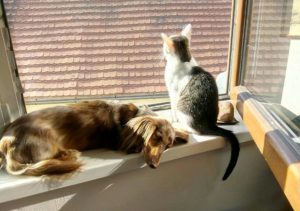At Family Friends Veterinary Hospital, we understand that pets are cherished family members, and their safety is paramount. July is Lost Pet Prevention Month, a time to raise awareness about the steps every pet owner can take to keep their furry friends safe and secure. Losing a pet is a heart-wrenching experience, but with proper precautions and proactive measures, you can significantly reduce the risk. In this blog post, we’ll discuss the importance of lost pet prevention and provide practical tips to ensure your pet stays safe and sound.
The Importance of Lost Pet Prevention
Every year, millions of pets go missing, and while many are eventually reunited with their owners, others are not as fortunate. The emotional toll of losing a pet can be overwhelming, and the uncertainty of their well-being is distressing. Lost Pet Prevention Month aims to educate pet owners about the strategies and tools available to prevent such heartache. By taking proactive steps, you can enhance your pet’s safety and increase the likelihood of a happy reunion if they ever wander off.
Microchipping: A Lifesaver for Lost Pets
One of the most effective ways to ensure your pet can be identified if they become lost is through microchipping. A microchip is a small, rice-sized device implanted under your pet’s skin, usually between the shoulder blades. This chip contains a unique identification number linked to your contact information in a national database. If your pet is found and taken to a veterinary clinic or animal shelter, the chip can be scanned, and you’ll be contacted promptly.
Benefits of Microchipping:
-
- Permanent Identification: Unlike collars and tags, which can fall off or be removed, a microchip provides a permanent form of identification.
- Quick Reunions: Microchipped pets are more likely to be reunited with their owners quickly, reducing stress for both the pet and the owner.
- International Recognition: Microchips are recognized globally, making it easier to reunite with your pet if they are lost while traveling.
Tips for Microchipping:
-
- Ensure your contact information in the microchip registry is up-to-date.
- Schedule an annual check-up with your veterinarian to ensure the microchip is functioning correctly.
- Consider microchipping even if your pet is an indoor-only animal; accidents can happen, and an extra layer of security is always beneficial.
Proper Identification: Collars and Tags
While microchipping is crucial, traditional forms of identification like collars and tags also play an essential role in lost pet prevention. A collar with an ID tag provides an immediate way for someone to contact you if they find your pet.
Choosing the Right Collar and Tag:
-
- Durable Material: Select a collar made from durable material that can withstand your pet’s activities.
- Comfort: Ensure the collar fits snugly but comfortably around your pet’s neck. It should be tight enough that it won’t slip off but loose enough to fit two fingers underneath.
- Clear Information: The ID tag should include your pet’s name, your phone number, and any pertinent medical information (such as a medical condition or medication needs).
Secure Your Home and Yard
Pets, especially curious and adventurous ones, can find ways to escape from seemingly secure environments. Regularly inspect your home and yard to ensure there are no potential escape routes.
Home Safety Tips:
-
- Doors and Windows: Ensure all doors and windows close securely. Consider installing pet-proof screens.
- Fencing: Regularly check your yard’s fencing for gaps, holes, or weak spots that your pet could exploit.
- Gates: Keep gates securely closed and consider installing a lock to prevent accidental openings.
Leash Training and Supervised Outdoor Time
Leash training is essential for dogs and can be beneficial for cats as well. Walking your pet on a leash provides them with exercise and mental stimulation while keeping them safe.
Leash Training Tips:
-
- Start Early: Begin leash training when your pet is young to help them get accustomed to it.
- Positive Reinforcement: Use treats and praise to reward your pet for walking calmly on a leash.
- Supervised Outdoor Time: Even in a fenced yard, supervise your pet’s outdoor activities to prevent escapes and ensure their safety.
Spay and Neuter Your Pets
Spaying and neutering your pets not only helps control the pet population but also reduces the likelihood of them roaming in search of a mate. Pets that are not spayed or neutered are more likely to wander off, increasing their risk of becoming lost.
Travel Safely with Your Pet
Whether you’re taking a trip to the vet or going on a family vacation, ensuring your pet’s safety during travel is crucial.
Travel Safety Tips:
-
- Secure Carrier: Use a secure carrier or crate for your pet during car rides.
- Harness: If your pet rides in the car outside of a carrier, use a pet-specific seat belt harness and seat belt attachment.
- Identification: Ensure your pet is wearing a collar with an ID tag and is microchipped before traveling.
- Emergency Kit: Pack an emergency kit with your pet’s essentials, including food, water, medications, and a recent photo of your pet.
Utilize Technology: GPS Collars and Trackers
Advancements in technology have made it easier to keep track of your pet’s whereabouts. GPS collars and trackers allow you to monitor your pet’s location in real-time using a smartphone app.
Benefits of GPS Collars and Trackers:
-
- Real-Time Tracking: Instantly locate your pet if they go missing.
- Geo-Fencing: Set up safe zones and receive alerts if your pet leaves these areas.
- Activity Monitoring: Track your pet’s activity levels to ensure they are getting enough exercise.
Community Awareness and Involvement
Building a network within your community can be invaluable in preventing lost pets. Get to know your neighbors and inform them about your pets. If your pet goes missing, having more people aware of their identity increases the chances of a quick reunion.
Community Tips:
-
- Social Media: Join local pet-focused social media groups where you can share information if your pet goes missing.
- Posters: Have recent photos of your pet on hand to create missing pet posters quickly if needed.
- Local Shelters: Familiarize yourself with local animal shelters and rescue organizations so you can contact them promptly if your pet is lost.
Conclusion
At Family Friends Veterinary Hospital, we are committed to helping you keep your pets safe and secure. Lost Pet Prevention Month is an opportunity to take proactive steps to protect your furry family members. By microchipping, ensuring proper identification, securing your home, leash training, and utilizing modern technology, you can significantly reduce the risk of losing your pet. Remember, preparation and vigilance are key. Let’s work together to keep our pets safe and ensure that they remain happy, healthy, and by our sides where they belong.
For more information or to schedule a microchipping appointment, contact Family Friends Veterinary Hospital today. Together, we can make a difference in the lives of our beloved pets.









